Writing about literary magazines in 1930, Ezra Pound noted that “The work of writers who have emerged in or via such magazines outweighs in permanent value the work of the writers who have not emerged in this manner. The history of contemporary letters has, to a very manifest extent, been written in such magazines.” Such a pronouncement is equally true of the present: many of our finest contemporary writers made their debuts in these “little magazines,” and many continue to publish new and exciting work in these publications.
 Travis Kurowski, one of the foremost scholars of this literary world, posits in Paper Dreams that “literary magazines, due to their subject matter and even the smallness of their production,” might “create a somehow more significant and longer lasting community than larger circulation magazines and newspapers.” Online and print literary magazines capture and document the literary moment.
Travis Kurowski, one of the foremost scholars of this literary world, posits in Paper Dreams that “literary magazines, due to their subject matter and even the smallness of their production,” might “create a somehow more significant and longer lasting community than larger circulation magazines and newspapers.” Online and print literary magazines capture and document the literary moment.
Editors serve an essential role in that process. My years of working with editors as a contributor have taught me that they are passionate, discerning stewards. It is often a thankless job to cull through thousands of submissions and deliver far more rejections than acceptances. Yet editors love the opportunity to make discoveries, to champion work, to shape and finally share an issue with readers.
Since they are so devoted to their publications, I asked editors of seven great literary magazines to select their favorite issues. Here are their choices.
1. Poetry – Don Share, editor – February 1931
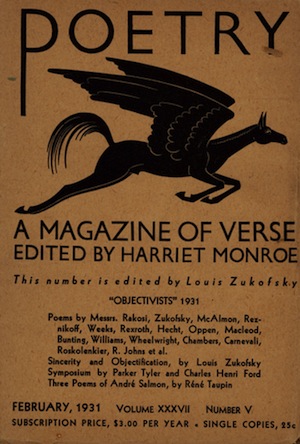 Like any editor, I’m humbly obliged to feel that the best issue of Poetry is the one I’m working on now, but literary history tends not only to humble, but lay low, most editors: think Thomas Wentworth Higginson, somehow failing to publish Emily Dickinson. So my choice will have to be our so-called “Objectivists” issue of February 1931. It was guest-edited for Harriet Monroe by Louis Zukofsky. Zukofsky had been a contributor since 1924, and at Ezra Pound’s urging (they’d met in 1927), Harriet agreed to let Zuk put together an issue of the magazine. It became something of an albatross for him later (apologies for that metaphor), but the issue was a great success for Poetry. Featuring such later luminaries as Charles Reznikoff, Carl Rakosi, George Oppen, Basil Bunting, William Carlos Williams, and Kenneth Rexroth, among others, it became a kind of blueprint for Anglo-American modernist poetry; and “objectivism” is in all the literary history books now. An unfortunate and conspicuous aspect of this is how white and male the table of contents is. Still, it was our most influential issue. Despite its indisputably legendary status, it also featured work seldom spoken of today: a poem by Whittaker Chambers, who would become infamous later with the Alger Hiss trials; a long-forgotten Imagist poem by Martha Champion, who was a student at the University of Wisconsin; and a statement on poetry by Charles Henri Ford and Parker Tyler so mystifying and obscure that it required a further statement by Zuk and then a rebuttal to that from Ford and Tyler; alas, it’s been that way for poetry ever since. Above all, I love Zukofsky’s frustrated account of the editorial process, for as it turns out, there was no such thing as objectivism:
Like any editor, I’m humbly obliged to feel that the best issue of Poetry is the one I’m working on now, but literary history tends not only to humble, but lay low, most editors: think Thomas Wentworth Higginson, somehow failing to publish Emily Dickinson. So my choice will have to be our so-called “Objectivists” issue of February 1931. It was guest-edited for Harriet Monroe by Louis Zukofsky. Zukofsky had been a contributor since 1924, and at Ezra Pound’s urging (they’d met in 1927), Harriet agreed to let Zuk put together an issue of the magazine. It became something of an albatross for him later (apologies for that metaphor), but the issue was a great success for Poetry. Featuring such later luminaries as Charles Reznikoff, Carl Rakosi, George Oppen, Basil Bunting, William Carlos Williams, and Kenneth Rexroth, among others, it became a kind of blueprint for Anglo-American modernist poetry; and “objectivism” is in all the literary history books now. An unfortunate and conspicuous aspect of this is how white and male the table of contents is. Still, it was our most influential issue. Despite its indisputably legendary status, it also featured work seldom spoken of today: a poem by Whittaker Chambers, who would become infamous later with the Alger Hiss trials; a long-forgotten Imagist poem by Martha Champion, who was a student at the University of Wisconsin; and a statement on poetry by Charles Henri Ford and Parker Tyler so mystifying and obscure that it required a further statement by Zuk and then a rebuttal to that from Ford and Tyler; alas, it’s been that way for poetry ever since. Above all, I love Zukofsky’s frustrated account of the editorial process, for as it turns out, there was no such thing as objectivism:
“Harriet Monroe at the time insisted, we’d better have a title for it, call it something. I said, I don’t want to. She insisted; so, I said, alright, if I can define it in an essay, and I used two words, sincerity and objectification, and I was sorry immediately. But it’s gone down into the history books; they forgot the founder, thank heavens, and kept the terms, and, of course, I said objectivist, and they said objectivism and that makes all the difference. Well, that was pretty bad, so then I spent the next thirty years trying to make it simple.”
Most Poetry readers will have heard of Pound’s dictum to “make it new,” but in reality, this issue of the magazine may well have taught many the virtue of keeping it simple.
2. West Branch – G.C. Waldrep, editor – Spring/Summer 2015
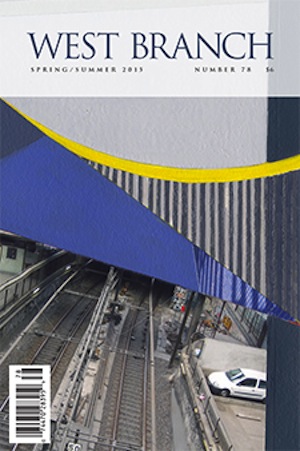 One issue! So hard, even in the handful of years since I took over West Branch in 2011 — all the children are exceptional, and all of them are deeply-loved. That said: for me, one of the joys of putting together an issue of a journal is trying to imagine lines of coherence between, across, and among different works. I spend hours ordering each issue, thinking about these lines, imagining how different works interact with one another. In that sense, my current favorite is WB 78. This issue was, for me, grounded in two great short stories — Benjamin Parzybok’s “News of the Week” and Victor Robert Lee’s “Border Control.” They’re very different, but each time I read them I feel a slug of adrenaline enter my system, and I feel extraordinarily honored to have been the one who brought them to a wider audience. Each is obsessed with the gaps in desire — the dead zones in which desire, through its absence, bides its time. There are other echoes throughout the issue: Parzybok’s taxidermied gorilla echoed in Charlie Clark’s poem “Elegy to a Black Bear Head Poorly Stuffed and Mounted;” the body augmented by damage in Patrick Roscoe’s dreamy story “Beggars” and Roxane Gay’s “Ugly Love,” and again in Brian D. Morrison’s poem “A History of Biting Circa 1599.” Kasey Erin Phifer-Byrne’s circus poems imagine fire-eating, lion-taming as more ways the body expresses its own insufficiency. “I can / look away from you whenever I want,” Corey Van Landingham’s speaker asserts in “Exegesis” — but in the end (of the following poem, and otherwise), it’s the irreducible body of the other, its incompletion, its hunger: “To drink the same milk as a boy / in the city, never considering his mouth.” His mouth, like the white polar bear you can no longer not imagine. Yes.
One issue! So hard, even in the handful of years since I took over West Branch in 2011 — all the children are exceptional, and all of them are deeply-loved. That said: for me, one of the joys of putting together an issue of a journal is trying to imagine lines of coherence between, across, and among different works. I spend hours ordering each issue, thinking about these lines, imagining how different works interact with one another. In that sense, my current favorite is WB 78. This issue was, for me, grounded in two great short stories — Benjamin Parzybok’s “News of the Week” and Victor Robert Lee’s “Border Control.” They’re very different, but each time I read them I feel a slug of adrenaline enter my system, and I feel extraordinarily honored to have been the one who brought them to a wider audience. Each is obsessed with the gaps in desire — the dead zones in which desire, through its absence, bides its time. There are other echoes throughout the issue: Parzybok’s taxidermied gorilla echoed in Charlie Clark’s poem “Elegy to a Black Bear Head Poorly Stuffed and Mounted;” the body augmented by damage in Patrick Roscoe’s dreamy story “Beggars” and Roxane Gay’s “Ugly Love,” and again in Brian D. Morrison’s poem “A History of Biting Circa 1599.” Kasey Erin Phifer-Byrne’s circus poems imagine fire-eating, lion-taming as more ways the body expresses its own insufficiency. “I can / look away from you whenever I want,” Corey Van Landingham’s speaker asserts in “Exegesis” — but in the end (of the following poem, and otherwise), it’s the irreducible body of the other, its incompletion, its hunger: “To drink the same milk as a boy / in the city, never considering his mouth.” His mouth, like the white polar bear you can no longer not imagine. Yes.
3. The Iowa Review – Jenna Hammerich, deputy managing editor – Fall 2009
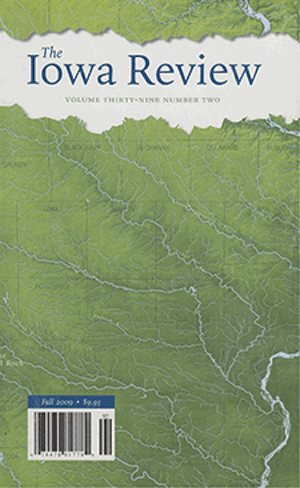 My favorite issue of The Iowa Review is our Fall 2009 river-themed issue. In 2008, the Iowa River and its tributaries flooded so badly that FEMA pronounced 85 of Iowa’s 99 counties disaster areas. As a nation, it seems, we tend to use our rivers and forget them, though they’re as essential to our identities as they are to our ecosystems. As our then-editor David Hamilton put it, “We all tend toward belonging to a river.” A collection of carefully curated essays, stories, poems, drawings, and photos of/about rivers, our Fall 2009 issue offers “our representation of River.” In it, artists and scholars from across the country consider rivers’ environmental, industrial, and psychological importance, their various histories and roles in our lives, and the lamentable condition of so many of them. Frederic Will, Fleda Brown, Laura Sayre, and David Wagoner elegize/analyze the rivers in their lives; Amy Leach and Ashleigh Pedersen imagine new rivers, new responses; Anat Pick articulates a river via sound poetry. I’ve never learned so much from one of our issues or been so grateful to have had a hand in publishing it.
My favorite issue of The Iowa Review is our Fall 2009 river-themed issue. In 2008, the Iowa River and its tributaries flooded so badly that FEMA pronounced 85 of Iowa’s 99 counties disaster areas. As a nation, it seems, we tend to use our rivers and forget them, though they’re as essential to our identities as they are to our ecosystems. As our then-editor David Hamilton put it, “We all tend toward belonging to a river.” A collection of carefully curated essays, stories, poems, drawings, and photos of/about rivers, our Fall 2009 issue offers “our representation of River.” In it, artists and scholars from across the country consider rivers’ environmental, industrial, and psychological importance, their various histories and roles in our lives, and the lamentable condition of so many of them. Frederic Will, Fleda Brown, Laura Sayre, and David Wagoner elegize/analyze the rivers in their lives; Amy Leach and Ashleigh Pedersen imagine new rivers, new responses; Anat Pick articulates a river via sound poetry. I’ve never learned so much from one of our issues or been so grateful to have had a hand in publishing it.
4. New England Review – Carolyn Kuebler, editor – Summer 2015
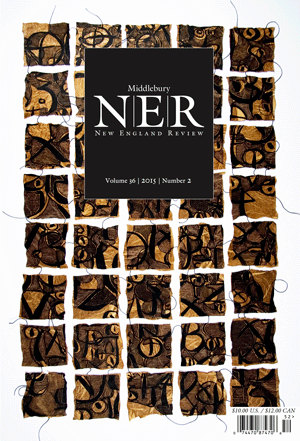 I’ve never been comfortable with the word “best,” but I can’t resist the chance to think about what would make one issue of New England Review better than another, or at least to say what makes an issue — any issue — good. Better. Best. “The China issue,” as we call it around the office, comes to mind both for aspirational reasons and for what it turned out to be. We aspire to publishing more international writing, in a more deliberate way, and putting together this issue taught me how to do that; but it also taught me how, despite their obvious similarities, the China-related writings were just as varied and fit just as well (often better) with their English-language neighbors as with each other. In Vol. 36, #2, Summer 2015, we published reverent, mysterious poems in translation by Ya Shi that seemed to speak intimately with poems by David Baker and Bruce Bond. More politically edged poems by Xiao Kaiyu complemented Wendy Willis’s thoughtful essay about the artist Ai Weiwei, which paved the way for Jeff Staiger’s brainy David Foster Wallace critique. Yin Lichuan’s pop sensibility closed out the issue on the heels of Michael X. Wang’s short fiction about a rural Chinese village, its straight-shooting storytelling power reflecting that of Ed Skoog’s unsettling poem, which preceded it. An essay by the inimitable Marianne Boruch about, as she says, “poetry as diagnosis,” deepened the conversation inwardly, while Camille Dungy’s essay about a trip to Maine showed us how the most superficial of kindnesses reveal something of our racial history. Now, looking back on the “China issue,” I marvel at how it also includes a high-voltage story by Steve de Jarnatt, subtle and gorgeous fiction by Carla Panciera and Sharon Solwitz, James Naremore’s thoughts on Orson Welles at 100, and haunting love poems — if they can even be called that — by Kazim Ali and Vandana Khanna. So, yes, 36.2. Now that was an issue.
I’ve never been comfortable with the word “best,” but I can’t resist the chance to think about what would make one issue of New England Review better than another, or at least to say what makes an issue — any issue — good. Better. Best. “The China issue,” as we call it around the office, comes to mind both for aspirational reasons and for what it turned out to be. We aspire to publishing more international writing, in a more deliberate way, and putting together this issue taught me how to do that; but it also taught me how, despite their obvious similarities, the China-related writings were just as varied and fit just as well (often better) with their English-language neighbors as with each other. In Vol. 36, #2, Summer 2015, we published reverent, mysterious poems in translation by Ya Shi that seemed to speak intimately with poems by David Baker and Bruce Bond. More politically edged poems by Xiao Kaiyu complemented Wendy Willis’s thoughtful essay about the artist Ai Weiwei, which paved the way for Jeff Staiger’s brainy David Foster Wallace critique. Yin Lichuan’s pop sensibility closed out the issue on the heels of Michael X. Wang’s short fiction about a rural Chinese village, its straight-shooting storytelling power reflecting that of Ed Skoog’s unsettling poem, which preceded it. An essay by the inimitable Marianne Boruch about, as she says, “poetry as diagnosis,” deepened the conversation inwardly, while Camille Dungy’s essay about a trip to Maine showed us how the most superficial of kindnesses reveal something of our racial history. Now, looking back on the “China issue,” I marvel at how it also includes a high-voltage story by Steve de Jarnatt, subtle and gorgeous fiction by Carla Panciera and Sharon Solwitz, James Naremore’s thoughts on Orson Welles at 100, and haunting love poems — if they can even be called that — by Kazim Ali and Vandana Khanna. So, yes, 36.2. Now that was an issue.
5. Brevity – Dinty W. Moore, editor – Fall 2015
It is of course excruciatingly difficult to pick out one favorite issue after 18.5 years, and the truth is, usually the upcoming issue is the real favorite, the one that the editors are most excited about. That’s how it should be, if the magazine is thriving and growing. But to say “the next issue is my favorite” would be a cop-out, so I’ll pick our 50th issue, from Fall 2015, for a few excellent reasons: (1) The issue features two of our most frequent contributors, Rebecca McClanahan and Diane Seuss (and they are frequent because they rock words); (2) We finally snagged a writer I’ve long admired, River Teeth editor Joe Mackall, after years of begging him to send something along; (3) The issue is truly international with work by Shahnaz Habib, an Indian writer eating in a Yemeni restaurant, Lina Ferreira, born and raised in Bogota, Colombia, Cary Tennis of Salon fame, now living full-time in France, and Matthew Komatsu, an American but writing about his stint in Afghanistan; and finally (4) All the work is solid, surprising, and strong.
6. Tin House – Rob Spillman, editor – Fall 2007
 How can you possibly have a favorite amongst your children? In my case, 67 children or issues of Tin House? The most fun and rewarding, though, might have to be Issue #33, in the Fall of 2007, called “Fantastic Women.” It sprung out of conversations I had with Rick Moody, where we tried to grasp a certain moment we were noticing, that there was something going on with women writers who were pushing the speculative envelope, that their work was distinct from their male colleagues, weirder, more hybrid. I enlisted Moody to help us put together an issue completely devoted to these women (still the only issue of Tin House that has had a guest co-editor). We were blown away by the contributions. It was a thrill to unleash fierce new work by writers like Aimee Bender, Kate Bernheimer, Lucy Corin, Julia Elliott, Samantha Hunt, Shelley Jackson, Stacey Levin, Kelly Link, Lydia Millet, Alissa Nutting, Stacey Richter, and Julia Slavin. It is still one of our most talked-about issues, and one we have subsequently anthologized and expanded into book form.
How can you possibly have a favorite amongst your children? In my case, 67 children or issues of Tin House? The most fun and rewarding, though, might have to be Issue #33, in the Fall of 2007, called “Fantastic Women.” It sprung out of conversations I had with Rick Moody, where we tried to grasp a certain moment we were noticing, that there was something going on with women writers who were pushing the speculative envelope, that their work was distinct from their male colleagues, weirder, more hybrid. I enlisted Moody to help us put together an issue completely devoted to these women (still the only issue of Tin House that has had a guest co-editor). We were blown away by the contributions. It was a thrill to unleash fierce new work by writers like Aimee Bender, Kate Bernheimer, Lucy Corin, Julia Elliott, Samantha Hunt, Shelley Jackson, Stacey Levin, Kelly Link, Lydia Millet, Alissa Nutting, Stacey Richter, and Julia Slavin. It is still one of our most talked-about issues, and one we have subsequently anthologized and expanded into book form.
7. Shenandoah – RT Smith, editor – Spring/Fall 2010
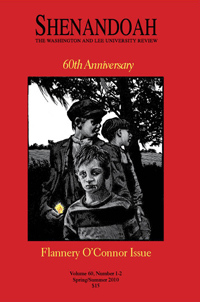 Since a group of Washington and Lee students, including one T.K. Wolfe, founded Shenandoah in 1950, the magazine has published over 200 issues, either in paper or online, so it’s nearly impossible even to contrive a method for selecting the “best” issue — the one with a Seamus Heaney essay? the Ha Jin story? the Native American issue? issues with James Merrill poems or Marianne Moore poems? the issue featuring Richard Wilbur’s essay “Poetry and Happiness?” Instead, I’ve simply chosen my personal favorite, Volume 60, Number 1-2, perhaps due to the work involved and the pleasure I have derived from editing it and re-reading it.
Since a group of Washington and Lee students, including one T.K. Wolfe, founded Shenandoah in 1950, the magazine has published over 200 issues, either in paper or online, so it’s nearly impossible even to contrive a method for selecting the “best” issue — the one with a Seamus Heaney essay? the Ha Jin story? the Native American issue? issues with James Merrill poems or Marianne Moore poems? the issue featuring Richard Wilbur’s essay “Poetry and Happiness?” Instead, I’ve simply chosen my personal favorite, Volume 60, Number 1-2, perhaps due to the work involved and the pleasure I have derived from editing it and re-reading it.
The Spring/Fall issue of 2010 is a bright red, perfect-bound book of 264 pages adorned with a print of Barry Moser’s woodcut “Mrs. Cope’s Nemesis,” an illustration for the story “A Circle in the Fire.” Inscribed in yellow are “60th Anniversary Issue” and “A Tribute to Flannery O’Connor.”
Not all the 20 poems are as directly Flannery-related as Claudia Emerson’s trio of character portraits (of Red Sam, LucyNell and Hulga) or Rita Mae Reese’s “Apocrypha: Flannery and the Book of Tobit,” but verse by Rodney Jones, Charles Wright, Dave Smith, and Betty Adcock fan the flames of gothic wit and regionally-sown universality.
And there’s much more to savor — Flannery essays biographical, theological, geographical, anecdotal, and feminist; fiction (by Ron Rash and Joyce Carol Oates) directly referential to the Georgia’s National Book Award-winning Flannery, as well as more obliquely related narratives (by Starkey Flythe, Fred Chappell, Honorée Fanonne Jeffers), photos of the O’Connor farm Andalusia, cartoons, collages, letters from the peacock-loving author to Shenandoah editors.
And I wouldn’t want anyone to miss LaWanda Walters verse homage “Piano Legs,” which brings Glenn Gould and Johann Sebastian Bach to “Good Country People” and the Misfit in that infamous parrot shirt. Nor Marlon Barton’s moving story “Pasture Art,” which is a visceral account of human suffering and the wishful near-miracle of “a hay dragon spitting red-tin fire” to animate and complete a collection of folk art.
No one could bring to the mysteries of airy nothingness a local habitation and a name better than O’Connor, but those who have followed the trail she blazed have kept the spirit alive, and this issue of Shenandoah, I think, has done a respectable job of compiling and packaging some of the artifacts. Fortunately, we still have 50 or 60 copies for sale.









